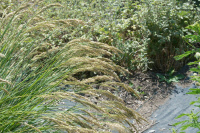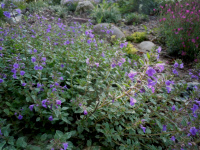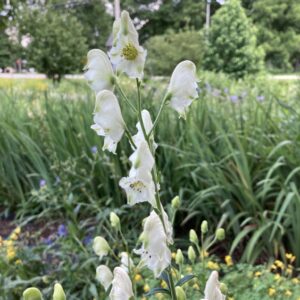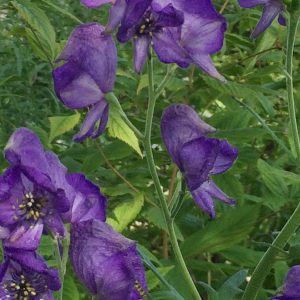Shop
Showing 9–16 of 778 results
-
Achillea tomentosa Woolly yarrow Z 4-8
Lemony colored platter-like flower heads from June to July atop a spray of wooly foliage.
OUT OF STOCK
Lemony colored platter-like flower heads from June to July atop a spray of wooly foliage.
Size: 8” x 12”
Care: Full sun in moist to dry soil
Native: Southern to Eastern Europe
Awards: Royal Horticultural Society Award of Garden Merit.Grown in garden of Tradescant the Elder’s (1570-1638) in 1630. ”A splendid plant with fern like foliage and rich golden-yellow flower heads.” H.H. Thomas, 1915. Philip Miller’s The Gardener’s Dictionary, describes this as having “finely cut” leaves with flowers “of a bright yellow colour, and continue long in beauty.” (1768)
Achillea named for Achilles, hero of Homer’s Iliad, who used a different Achillea to stop his soldiers’ bleeding at the siege of Troy. Tomentosa means “furry” or “covered in hairs”, referring to the leaves of this plant.**LISTED AS OUT OF STOCK BECAUSE WE DO NOT SHIP THIS ITEM. IT IS AVAILABLE FOR PURCHASE AT OUR RETAIL LOCATION.
-
Achlys triphylla Vanilla leaf, Sweet after death Z 5-9
A foot tall stem holds one large leaf divided into three, fan-shaped leaflets with deeply scalloped edges laying flat like a dinner plate. From spring to mid-summer an erect, white spike, not made of flowers, but made of stamens (the male part of plants that holds pollen) blooms.
OUT OF STOCK
A foot tall stem holds one large leaf divided into three, fan-shaped leaflets with deeply scalloped edges laying flat like a dinner plate. From spring to mid-summer an erect, white spike, not made of flowers, but made of stamens (the male part of plants that holds pollen) blooms.
Size: 8-16" x spreading by roots.
Care: shade to part shade in moist to moist well-drained soil
Native: mountains of the western US and Canadian coast up to nearly 5000’Natives of the Pacific Northwest used this medicinally to treat tuberculosis, cataracts, and induce vomiting, They also washed their hair with it and as an insecticide to repel or kill mosquitos, bedbugs and lice on sheep,
Both common names describe the sweet smell of its dried foliage. Collected by “Archibald Menzies on the west coast of North America.” Menzies (1754-1842) sailed on the Vancouver Expedition collecting many plants in 1787-1788. Cyclopedia or Universal Dictionary of Arts. Sciences, and Literature v. 20, p. (1812) where Sir James Edward Smith described and named it Loentic tripylla means Lion’s-leaf. Tripylla means three fruits. Renamed later. -
Achnatherum calamagrostis Silver spike grass Z 5-8
graceful, tawny-silvery spikes on this clumping grass
Gorgeous, graceful, tawny-silvery spikes on this clumping grass from June all summer
Size: 36" x 36"
Care: sun in moist well-drained to well-drained soil
Native: Central & southern EuropeCollected before 1750
-
Acinos alpinus syn. Calamintha alpina syn Clinopodium alpinus
Reddish purple flowers all summer and fall
OUT OF STOCK
Reddish purple flowers bloom on cushions all summer and fall – “long and late season of bloom.” Foster
Size: 4-6”x 8”
Care: sun in well-drained soil
Native: European mountains - Alps and PyreneesCollected before 1753.
Common name for its aromatic foliage. It has been used to reduce excessive sweating and fever. Also, leaves may be brewed for tea. -
Aconitum fischeri Fischer’s monkshood syn. A. carmichaelii
Spikes of cobalt blue hooded blooms September – October
ARCHIVED
Note: This is a plant not currently for sale. This is an archive page preserved for informational use.
Spikes of cobalt blue hooded blooms September – October POISON
Size: 24-36”x 10”
Care: part shade in moist soil
Native: No. Japan, E. Russia, Korea, China
Wildlife Value: Deer resistant. Attracts butterflies.The name Aconitum is from the mythical hill Aconitus in Pontica where Hercules fought with Cerberus. Philip Miller in The Gardener’s Dictionary (1768) wrote that the name Aconitum comes from Greek word for dart “because the Barbarians used to daub their darts therewith.” The Monkshood reputedly sprang from the jaws of Cerberus, the guard dog of the underworld. In China called “bao ye wo tou.” Wm. Robinson considered this one of the best monkshoods. Collected before 1820.
-
Aconitum napellus ‘Albus’ White Monkshood, Wolfsbane Z 4-8 POISON
Purest of white hooded blooms flowering along spikes in mid to late summer
ARCHIVED
Note: This is a plant not currently for sale. This is an archive page preserved for informational use.
Purest of white hooded blooms flowering along spikes in mid to late summer
Size: 2-3” x 18-24”
Care: part shade, cool, moist soil
Native: EuropeThe name Aconitum is from the mythical hill Aconitus in Pontica where Hercules fought with Cerberus. The Monkshood reputedly sprang from the jaws of Cerberus, the guard dog of the underworld. Believed to make a potion that helped witches fly. This was identified by Dioscordies in De Materica Medica for medicinal use around 70 A.D. Philip Miller in The Gardener’s Dictionary (1768) wrote that the name Aconitum comes from Greek word for dart “because the Barbarians used to daub their darts therewith.” He also considered “in flower it makes a pretty appearance.”Used by physicians in 1200’s and to poison wolves: “This Wolf’s bayne of all poisons is the most hastie poison.” Wm. Turner, 1560’s. Called Monkshood due to the shape of each flower like a monk’s hood.
This white variety in English gardens before 1768, Philip Miller’s Garden Dictionary -
Aconitum napellus Monkshood Wolfsbane Z 5-8 POISON
Striking, late summer to fall tall stalks, top third covered with flowers, blue washed purple each topped with a hood, in ancient times like a monks’ hood, today like a sweatshirt’s hoody.
OUT OF STOCK
Striking, late summer to fall on the top third of tall stalks, covered with flowers, blue washed purple each topped with a hood, in ancient times like a monks’ hood, today like a sweatshirt’s hoody.
Size: 2-3’x 12”
Care: part shade, cool, moist soil
Native: Europe
Wildlife Value: Aconitums are unusual. They change sex, which, in turn increases procreation! When first blooming they have a “male phase” of about 5-6 days when pollen is available, and the plant produces more nectar and stronger scent. Then the male parts wither making the pollen available to the female parts. The pollen is toxic to bees so most avoid it leaving more for the female parts, therefore increasing fertilization. However, bees are able to collect nectar without harm. https://botany.one/2019/11/aconitum-offers-bees-more-nectar-to-carry-its-toxic-pollen/ Also deer resistant.
Awards: Elisabeth Carey Miller Botanical Garden Great Plant PicksThe name Aconitum is from the mythical hill Aconitus in Pontica where Hercules fought with Cerberus. The Monkshood reputedly sprang from the jaws of Cerberus, the guard dog of the underworld. Believed to make a potion that helped witches fly. Identified by Dioscorides in De Materica Medica for medicinal use c. 70 A.D. Philip Miller in The Gardener’s Dictionary (1768) wrote that the name Aconitum comes from Greek word for dart “because the Barbarians used to daub their darts therewith.” Used by physicians in 1200’s and to poison wolves: “This Wolf’s bayne of all poisons is the most hastie poison.” Wm. Turner, 1560’s. Called Monkshood due to the shape of each flower like a monk’s hood. Introduced to the new world by John Winthrop in 1631.
-
Actaea pachypoda syn. Actaea alba White baneberry Z 3-8
Short white spike flowers in June, conspicuous white berries in fall with a black dot on showy crimson stems.
OUT OF STOCK
Short white spike flowers in June, conspicuous white berries in fall with a black dot on showy crimson stems.
Size: 36”x 18-24”
Care: part to full shade in moist well-drained soil
Native: native to eastern and central No. America; Wisconsin native.
Wildlife Value: deer resistant
Awards: England’s Royal Horticultural Society Award of Merit and Great Plant Pick Award from Elizabeth Carey Miller Botanical Garden.Actaea is Latin meaning “elder,” the leaves resembling the elder tree. Pachypoda means thick foot referring to the stalk. The common name “baneberry” chosen because the berries are poisonous. The Blackfoot boiled the roots to cure coughs and colds. In the 1800’s, used to cure “reflex uterine headache, rheumatism, congestion in the female especially, debility and gastralgia.” Sent to England before 1768, Philip Miller.








